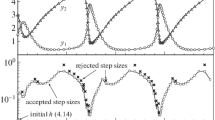Abstract
The automatic generation of FORTRAN code for finite element analysis is described. A software system running under the VAXIMA system is constructed to perform the analytical derivation and the FORTRAN code generation. Techniques for generating efficient code based on symmetries in the given problem are presented. Symmetry must be extracted and preserved in the analytical derivation phase. One such derivation for the isoparametric formulation in finite element analysis is presented. To gain more control over the code generated, mathematical derivation is interleaved with code generation actions. The ability to automatically generate functions and subroutines is important. An example is given to show how FORTRAN functions and function calls are generated under program control. Techniques discussed should be useful in other applications when a symbolic computation system is used to derive and generate code for numerical computation.
Work reported herein has been supported in part by the US National Aeronautics and Space Administration under Grant NAG 3-298 and in part by the Department of Energy under Grant DE-AC02-ER7602075-A013.
Preview
Unable to display preview. Download preview PDF.
Similar content being viewed by others
References
M. M. Cecchi and C. Lami, “Automatic generation of stiffness matrices for finite element analysis”, Int. J. Num. Meth. Engng 11, pp. 396–400, 1977.
T. Y. Chang, “NFAP — A Nonlinear Finite Element Analysis Program Vol. 2 — User's Manual”, Technical Report, College of Engineering, University of Akron, Akron Ohio, 1980.
J. K. Foderaro, Franz LISP Manual, University of California, Berkeley, California, 1983.
J. K. Foderaro and R. J. Fateman, “Characterization of VAX Macsyma”, Proceedings, ACM SYMSAC'81 Conference, Aug. 5–8, Snowbird, Utah, pp. 14–19, 1981.
B. W. Kerninghan and D. M. Ritchie, The C Programming Language, Prentice-Hall: Englewood Cliffs, New Jersey, 1978.
A. R. Korncoff and S. J. Fenves, “Symbolic generation of finite element stiffness matrices”, Comput. Structures, 10, pp. 119–124, 1979.
A. K. Noor and C. M Andersen, “Computerized Symbolic Manipulation in Nonlinear Finite Element Analysis”, Comput. Structures 13, pp. 379–403, 1981.
A. K. Noor and C. M. Andersen, “Computerized symbolic Manipulation in structural mechanics-progress and potential”, Comput. Structures 10, pp. 95–118, 1977.
P. S. Wang and B. Gates, “A LISP-based RATFOR Code Generator”, Proceedings, the Third MACSYMA Users Conference, August, 1984, pp. 319–329.
P. S. Wang, T. Y. P. Chang and J. A. van Hulzen, “Code Generation and Optimization for Finite Element Analysis”, Proceedings, EUROSAM'84, London, England, July 9–11, 1984, pp. 237–247.
P. S. Wang, “MACSYMA-Aided Finite Element Analysis: Techniques for the Generation of Numerical Programs”, Proceedings, the Third MACSYMA Users Conference, August, 1984, pp. 23–34.
UNIX programmer's manual, Vol. I and II, Seventh Edition, Bell Telephone Laboratories, Inc., Murray Hill, New Jersey, 1979.
Author information
Authors and Affiliations
Editor information
Rights and permissions
Copyright information
© 1985 Springer-Verlag Berlin Heidelberg
About this paper
Cite this paper
Wang, P.S. (1985). Taking advantage of symmetry in the automatic generation of numerical programs for finite element analysis. In: Caviness, B.F. (eds) EUROCAL '85. EUROCAL 1985. Lecture Notes in Computer Science, vol 204. Springer, Berlin, Heidelberg. https://doi.org/10.1007/3-540-15984-3_332
Download citation
DOI: https://doi.org/10.1007/3-540-15984-3_332
Published:
Publisher Name: Springer, Berlin, Heidelberg
Print ISBN: 978-3-540-15984-1
Online ISBN: 978-3-540-39685-7
eBook Packages: Springer Book Archive




